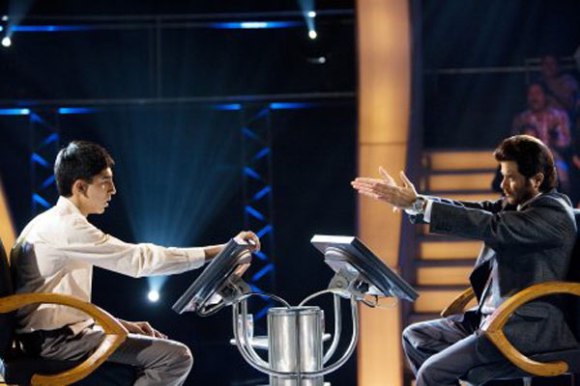Although I had already seen Danny Boyle’s 2008 film Slumdog Millionaire, it had been about three years, so I attempted to come into it with a clean slate. I tried to relate it to Vikas Swarup’s Q & A more than my previous knowledge of the film.
On that note, I was disappointed with the transposition of the novel to the film, especially regarding the overall structure. The novel was structured around 12 questions that Ram had been able to answer based upon his own life experiences. I thought this really tied together the narrative. Though I was skeptical about the seemingly illogical organization of the questions at the beginning, my qualms were resolved by the end: Ram had gone on the show to avenge Nita’s mistreatment at the hands of the Regis Philbin-wannabe.
The movie was arranged similarly, explaining how Jamal knew some of the answers based on his life experiences. However, some of the questions were given to him, either with the aid of a lifeline or with the announcer’s help (or lack thereof). I understand this was a way to condense the narrative in the name of time constraints. And though the idea that Ram was lucky enough to know every answer based on his life experiences is a bit contrived, I felt the novel was better executed than the movie. The only upside to the movie on this front was its ability to easily switch back and forth between the show and Jamal’s life. This provided a little more context and was more “in the moment.”
I also thought the religious aspect that was such a big part of the novel was missing from the film. The complexity of the main character’s name is evident in his three-part name: the Hindi name Ram, the Muslim name Ram, and the British name Thomas. This captures the religious divisions that define modern India. The film, however, didn’t communicate to me its religious stance, if there was any. Maybe I “watched it wrong,” but most of the film was spoken in Hindi, though “Jamal” and “Salim” are Muslim names. The scene at the beginning, when Jamal’s slum is attacked by Hindu zealots, indicates that he is Muslim, and the trains carrying the Hindus are obviously symbols of religious warfare here. However, this was the only instance (at least that I noticed) of a religious aspect, as compared to its complexity in the novel.
The film does, however, emphasize the issue of globalization. The quiz show in the novel is obviously a ripoff of Who Wants to be a Millionaire, but it at least disguises itself with a new name. The film, however, makes no such effort. It calls itself by the same name, uses the same lifelines, and looks like a carbon copy of Millionaire‘s set. The idea that India’s pop culture relies on America is offset by the fact that America’s workforce has been displaced to India. Jamal works at a call center in India and is taught to speak to people from across the world as though he were right down the street from them. I was instantly reminded of Aravind Adiga’s The White Tiger, which I had to read for my British Literature class. In this novel, the main character also works at a call center for a time. Both this novel and Slumdog Millionaire highlight the fact that the West outsources its workforce and then complains when the service is lacking.
The set of India’s Who Wants to Be a Millionaire? is almost a carbon copy of
America’s game show set.
Though I understand what the film was trying to accomplish, I think it fails as an adaptation of Q & A. The two texts were almost completely different, and both separately sufficient, but they do not work as a pair.

